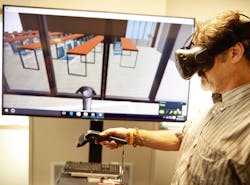Use Virtual and Augmented Realities in Your Renovation or Build
Virtual and augmented realities are quickly making their way into almost all industries, including construction and design. They are not just associated to video games or the future anymore.
Construction projects today are more complex than ever — faster schedules, tighter budgets and one-of-a-kind designs are all part of the process. It’s important that construction companies integrate technology into their practices to ensure projects are completed with the highest quality, at the best final cost.
Before any metal begins to fly, companies must face the task of ensuring that clients have peace of mind knowing they are receiving exactly what they want, and being able to fully immerse themselves into the space before construction has even begun is one of the many features that these state-of-the-art technologies can bring to the table.
Making any changes once construction has begun is extremely costly and can be a major headache for both clients and contractors. The integration of both virtual and augmented realities allow changes to be made virtually prior to any construction and can ensure peace of mind for clients going into any project.
Whether it’s for the sake of saving money or improving the customer experience, developers and construction experts alike are finding practical ways to incorporate these high tech features into everyday practices. And it’s improving the overall construction process for both workers and clients.
Virtual Reality vs. Augmented Reality
Virtual and augmented realities bring different benefits to the table within the construction and design phases of a project.
- Virtual reality (VR) gives clients the chance to immerse themselves into a computer rendered simulation, giving them the feel that they are inside of the completed project.
- Augmented reality (AR) is a real time overlay of a 3D hologram or model on top of a physical existing environment ideal for use in renovations and to review construction progress.
The immersive environment created by virtual reality provides clarity to multiple end users of a project, which enables them to provide faster and more reliable feedback on the design of their spaces. It is often said by clients that VR helps them not just see the space, but “feel” the space.
This time-saving aspect increases the quality of the design, which in turn correlates into efficient construction and can drastically reduce the lifecycle cost of a building. Augmented reality offers similar benefits beyond visualization. AR can analyze layouts and designs, and even predict problems before any work begins, allowing issues to be corrected before ground breaks.
During a renovation, it can be hard for people to envision new cabinets, walls or even paint colors.
[Sneak a Peek at World’s Largest Underwater Restaurant]
With augmented reality, contractors can highlight new features within a real space, allowing the vision to come to life in real time. AR can also catch issues before any construction begins and as construction progresses.
Laying 3D renderings on top of a current space, allows contractors to catch any design issues that are not constructible due to current conditions, such as piping or structure beams, before they become on-site issues. The invention of this relatively inexpensive technology allows companies to bypass the process of laser scanning or other time intensive approaches.
The technology is beneficial to owners of the buildings being constructed or renovated. The VR and AR technology is also beneficial to the employees that will be working in the facilities on a daily basis.
Take a hospital staff, for instance. Allowing critical staff, such as doctors and nurses, the chance to provide input could be an integral part of the final project. VR and AR allows them to step into a completed project and offer their input as to where specifics aspects of the room should be that will help them do their jobs in the best way possible.
Making any changes once construction has begun is extremely costly and can be a major headache for both clients and contractors. The integration of both virtual and augmented realities allow changes to be made virtually prior to any construction and can ensure peace of mind for clients going into any project.
Two handpicked articles to read next:
